Stakeholder Analysis Report: Examining Coles Myer Limited (MGT583)
VerifiedAdded on 2023/04/21
|5
|957
|152
Report
AI Summary
This report presents a stakeholder analysis of Coles Myer Limited, fulfilling the requirements of an MGT583 assignment. The analysis begins with a stakeholder map, categorizing stakeholders based on their interests and influence, following the models of stakeholder theory. The report identifies key stakeholders such as suppliers, employees, shareholders, local media, government, the community, consumers, and non-governmental organizations. The report then focuses on specific stakeholders that the company may neglect, particularly the local media and non-governmental organizations, discussing their interests and the potential impact of their neglect. The report suggests recommendations for improved engagement, such as including these groups in decision-making processes. The conclusion emphasizes the importance of regular stakeholder analysis for ensuring that the interests of all stakeholders are met. References from academic sources support the analysis.
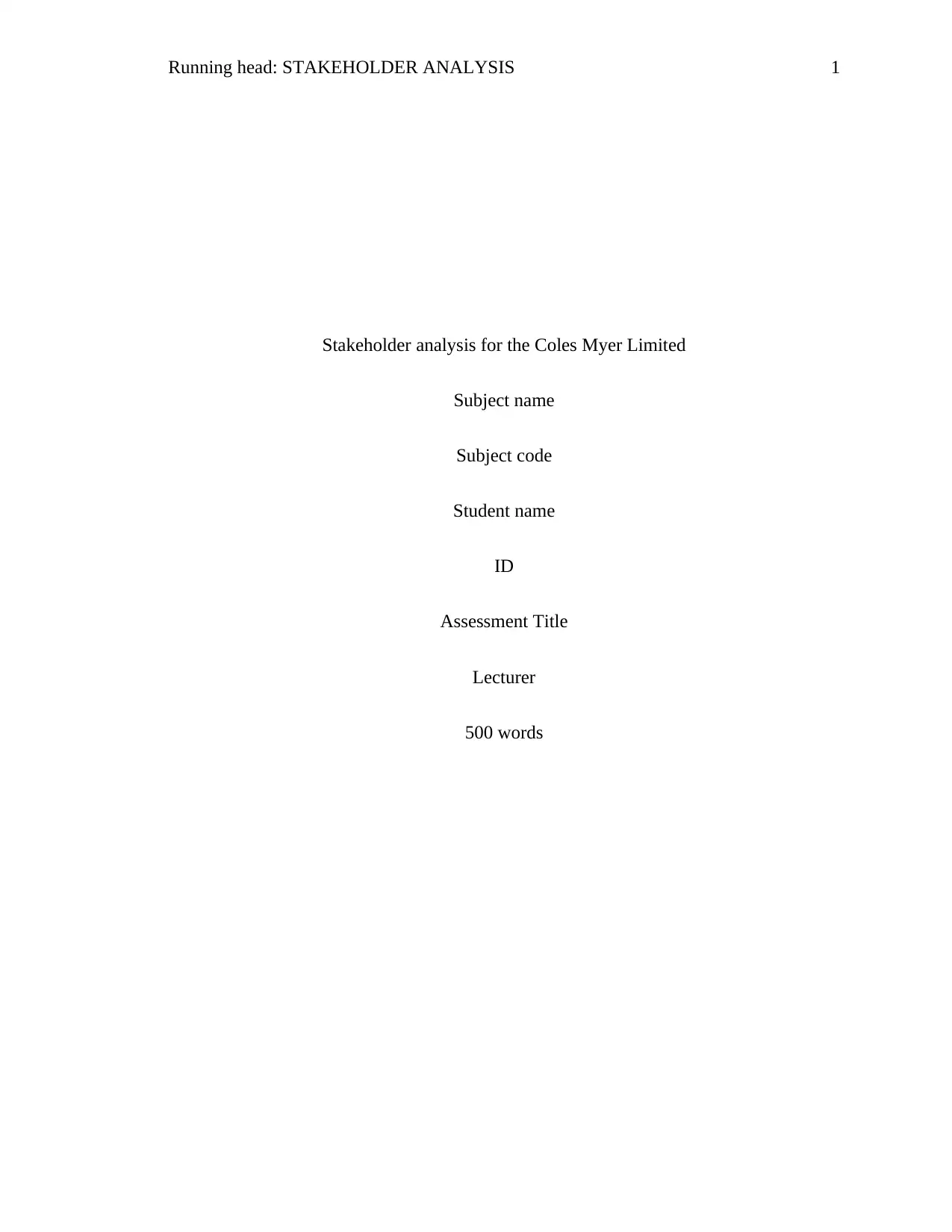
Running head: STAKEHOLDER ANALYSIS 1
Stakeholder analysis for the Coles Myer Limited
Subject name
Subject code
Student name
ID
Assessment Title
Lecturer
500 words
Stakeholder analysis for the Coles Myer Limited
Subject name
Subject code
Student name
ID
Assessment Title
Lecturer
500 words
Paraphrase This Document
Need a fresh take? Get an instant paraphrase of this document with our AI Paraphraser
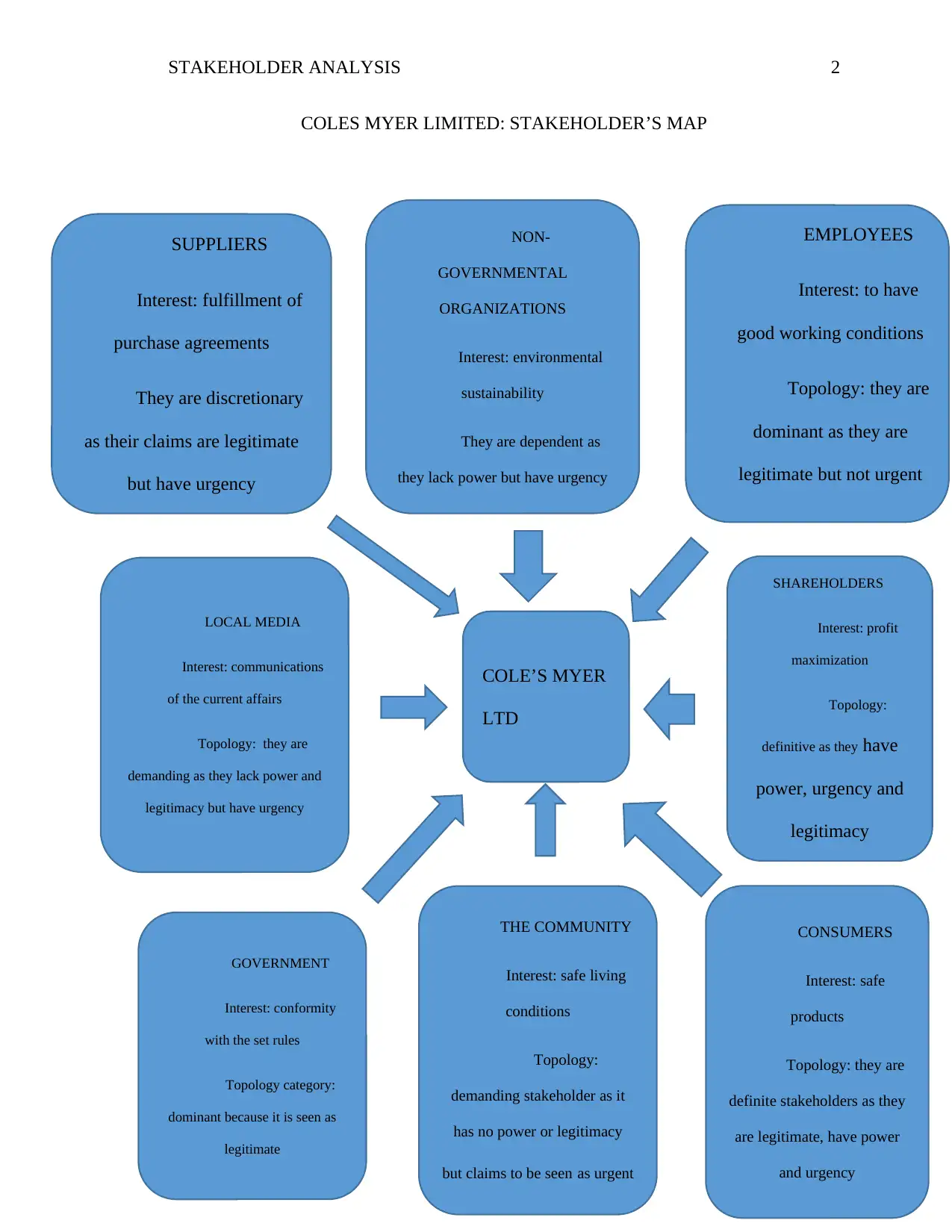
STAKEHOLDER ANALYSIS 2
COLES MYER LIMITED: STAKEHOLDER’S MAP
COLE’S MYER
LTD
SUPPLIERS
Interest: fulfillment of
purchase agreements
They are discretionary
as their claims are legitimate
but have urgency
EMPLOYEES
Interest: to have
good working conditions
Topology: they are
dominant as they are
legitimate but not urgent
LOCAL MEDIA
Interest: communications
of the current affairs
Topology: they are
demanding as they lack power and
legitimacy but have urgency
SHAREHOLDERS
Interest: profit
maximization
Topology:
definitive as they have
power, urgency and
legitimacy
GOVERNMENT
Interest: conformity
with the set rules
Topology category:
dominant because it is seen as
legitimate
THE COMMUNITY
Interest: safe living
conditions
Topology:
demanding stakeholder as it
has no power or legitimacy
but claims to be seen as urgent
CONSUMERS
Interest: safe
products
Topology: they are
definite stakeholders as they
are legitimate, have power
and urgency
NON-
GOVERNMENTAL
ORGANIZATIONS
Interest: environmental
sustainability
They are dependent as
they lack power but have urgency
COLES MYER LIMITED: STAKEHOLDER’S MAP
COLE’S MYER
LTD
SUPPLIERS
Interest: fulfillment of
purchase agreements
They are discretionary
as their claims are legitimate
but have urgency
EMPLOYEES
Interest: to have
good working conditions
Topology: they are
dominant as they are
legitimate but not urgent
LOCAL MEDIA
Interest: communications
of the current affairs
Topology: they are
demanding as they lack power and
legitimacy but have urgency
SHAREHOLDERS
Interest: profit
maximization
Topology:
definitive as they have
power, urgency and
legitimacy
GOVERNMENT
Interest: conformity
with the set rules
Topology category:
dominant because it is seen as
legitimate
THE COMMUNITY
Interest: safe living
conditions
Topology:
demanding stakeholder as it
has no power or legitimacy
but claims to be seen as urgent
CONSUMERS
Interest: safe
products
Topology: they are
definite stakeholders as they
are legitimate, have power
and urgency
NON-
GOVERNMENTAL
ORGANIZATIONS
Interest: environmental
sustainability
They are dependent as
they lack power but have urgency
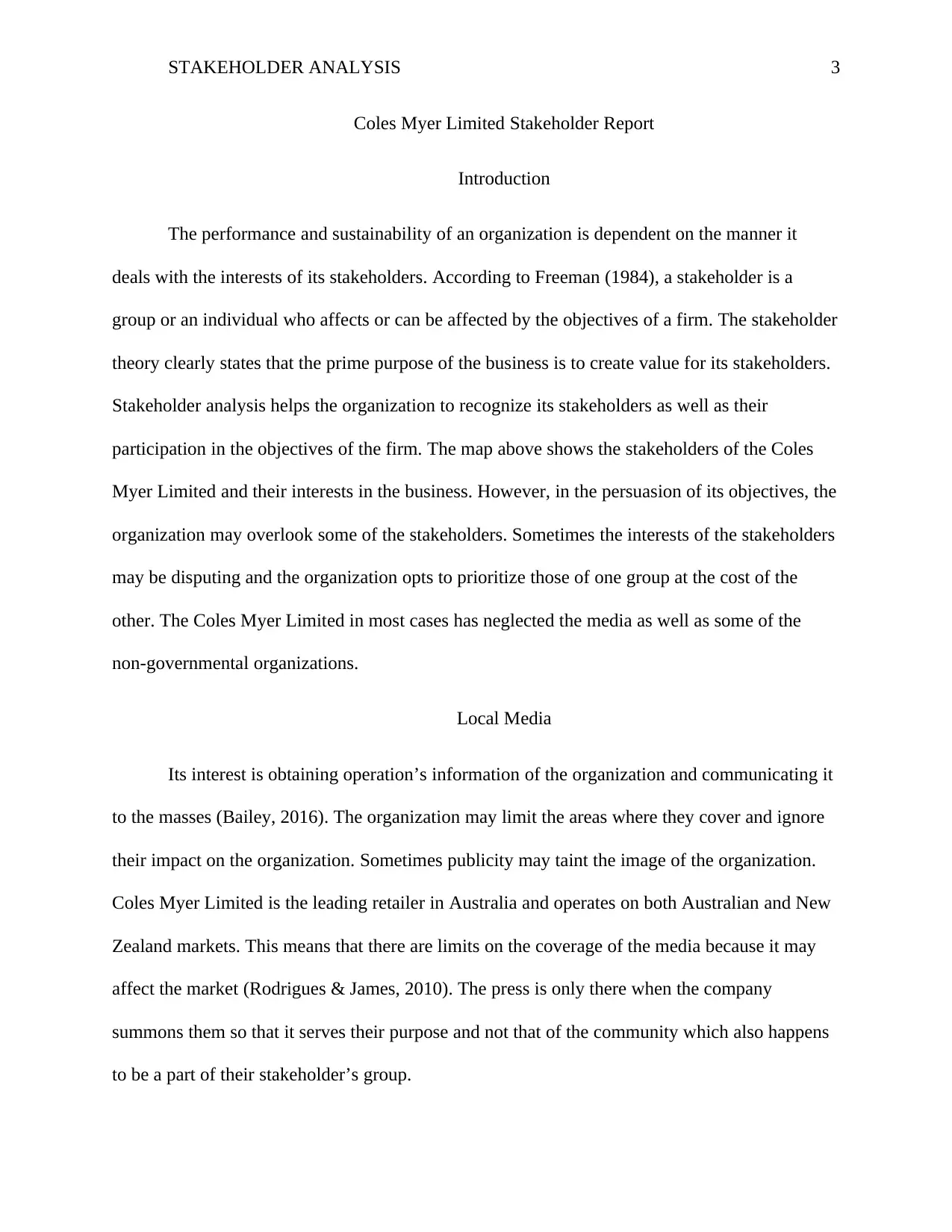
STAKEHOLDER ANALYSIS 3
Coles Myer Limited Stakeholder Report
Introduction
The performance and sustainability of an organization is dependent on the manner it
deals with the interests of its stakeholders. According to Freeman (1984), a stakeholder is a
group or an individual who affects or can be affected by the objectives of a firm. The stakeholder
theory clearly states that the prime purpose of the business is to create value for its stakeholders.
Stakeholder analysis helps the organization to recognize its stakeholders as well as their
participation in the objectives of the firm. The map above shows the stakeholders of the Coles
Myer Limited and their interests in the business. However, in the persuasion of its objectives, the
organization may overlook some of the stakeholders. Sometimes the interests of the stakeholders
may be disputing and the organization opts to prioritize those of one group at the cost of the
other. The Coles Myer Limited in most cases has neglected the media as well as some of the
non-governmental organizations.
Local Media
Its interest is obtaining operation’s information of the organization and communicating it
to the masses (Bailey, 2016). The organization may limit the areas where they cover and ignore
their impact on the organization. Sometimes publicity may taint the image of the organization.
Coles Myer Limited is the leading retailer in Australia and operates on both Australian and New
Zealand markets. This means that there are limits on the coverage of the media because it may
affect the market (Rodrigues & James, 2010). The press is only there when the company
summons them so that it serves their purpose and not that of the community which also happens
to be a part of their stakeholder’s group.
Coles Myer Limited Stakeholder Report
Introduction
The performance and sustainability of an organization is dependent on the manner it
deals with the interests of its stakeholders. According to Freeman (1984), a stakeholder is a
group or an individual who affects or can be affected by the objectives of a firm. The stakeholder
theory clearly states that the prime purpose of the business is to create value for its stakeholders.
Stakeholder analysis helps the organization to recognize its stakeholders as well as their
participation in the objectives of the firm. The map above shows the stakeholders of the Coles
Myer Limited and their interests in the business. However, in the persuasion of its objectives, the
organization may overlook some of the stakeholders. Sometimes the interests of the stakeholders
may be disputing and the organization opts to prioritize those of one group at the cost of the
other. The Coles Myer Limited in most cases has neglected the media as well as some of the
non-governmental organizations.
Local Media
Its interest is obtaining operation’s information of the organization and communicating it
to the masses (Bailey, 2016). The organization may limit the areas where they cover and ignore
their impact on the organization. Sometimes publicity may taint the image of the organization.
Coles Myer Limited is the leading retailer in Australia and operates on both Australian and New
Zealand markets. This means that there are limits on the coverage of the media because it may
affect the market (Rodrigues & James, 2010). The press is only there when the company
summons them so that it serves their purpose and not that of the community which also happens
to be a part of their stakeholder’s group.
⊘ This is a preview!⊘
Do you want full access?
Subscribe today to unlock all pages.

Trusted by 1+ million students worldwide
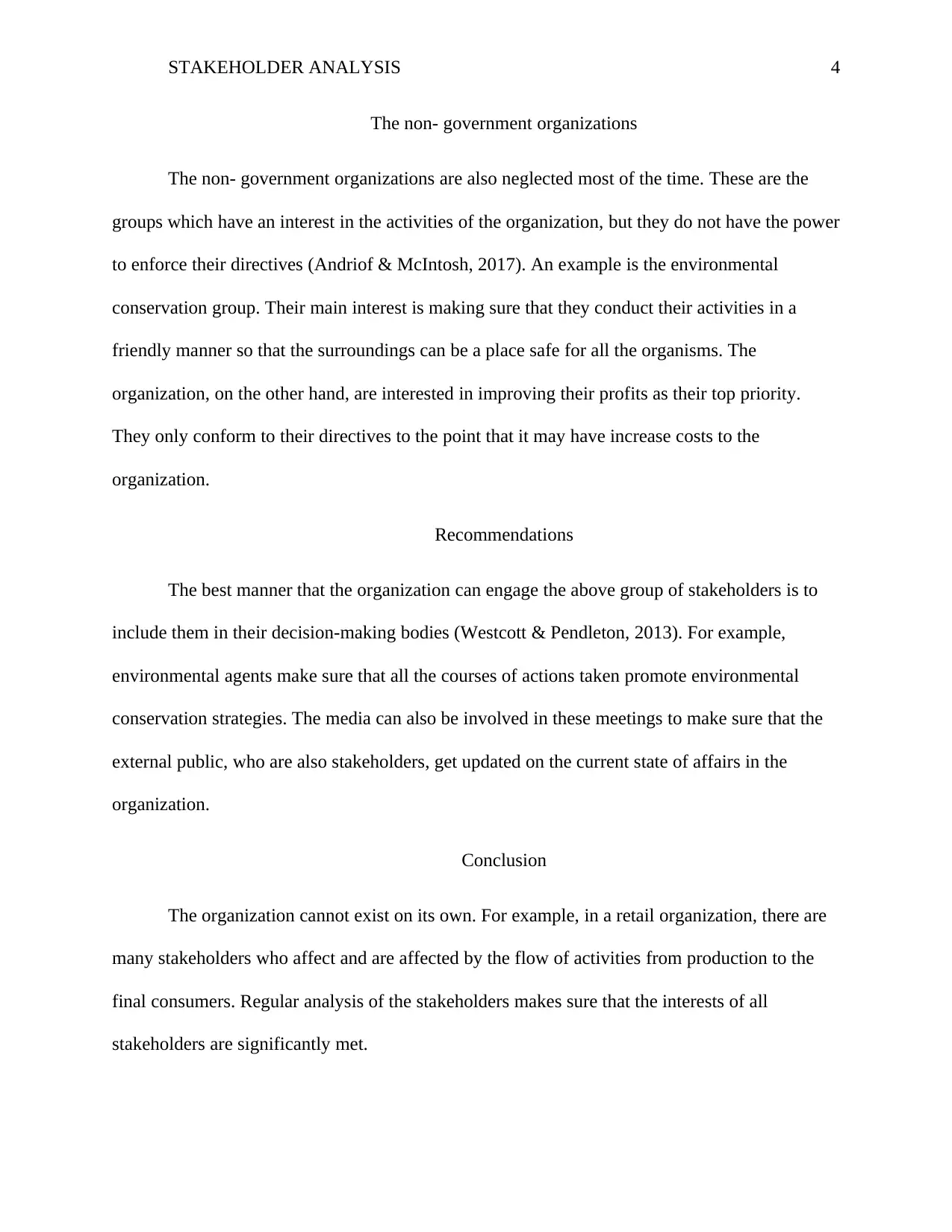
STAKEHOLDER ANALYSIS 4
The non- government organizations
The non- government organizations are also neglected most of the time. These are the
groups which have an interest in the activities of the organization, but they do not have the power
to enforce their directives (Andriof & McIntosh, 2017). An example is the environmental
conservation group. Their main interest is making sure that they conduct their activities in a
friendly manner so that the surroundings can be a place safe for all the organisms. The
organization, on the other hand, are interested in improving their profits as their top priority.
They only conform to their directives to the point that it may have increase costs to the
organization.
Recommendations
The best manner that the organization can engage the above group of stakeholders is to
include them in their decision-making bodies (Westcott & Pendleton, 2013). For example,
environmental agents make sure that all the courses of actions taken promote environmental
conservation strategies. The media can also be involved in these meetings to make sure that the
external public, who are also stakeholders, get updated on the current state of affairs in the
organization.
Conclusion
The organization cannot exist on its own. For example, in a retail organization, there are
many stakeholders who affect and are affected by the flow of activities from production to the
final consumers. Regular analysis of the stakeholders makes sure that the interests of all
stakeholders are significantly met.
The non- government organizations
The non- government organizations are also neglected most of the time. These are the
groups which have an interest in the activities of the organization, but they do not have the power
to enforce their directives (Andriof & McIntosh, 2017). An example is the environmental
conservation group. Their main interest is making sure that they conduct their activities in a
friendly manner so that the surroundings can be a place safe for all the organisms. The
organization, on the other hand, are interested in improving their profits as their top priority.
They only conform to their directives to the point that it may have increase costs to the
organization.
Recommendations
The best manner that the organization can engage the above group of stakeholders is to
include them in their decision-making bodies (Westcott & Pendleton, 2013). For example,
environmental agents make sure that all the courses of actions taken promote environmental
conservation strategies. The media can also be involved in these meetings to make sure that the
external public, who are also stakeholders, get updated on the current state of affairs in the
organization.
Conclusion
The organization cannot exist on its own. For example, in a retail organization, there are
many stakeholders who affect and are affected by the flow of activities from production to the
final consumers. Regular analysis of the stakeholders makes sure that the interests of all
stakeholders are significantly met.
Paraphrase This Document
Need a fresh take? Get an instant paraphrase of this document with our AI Paraphraser
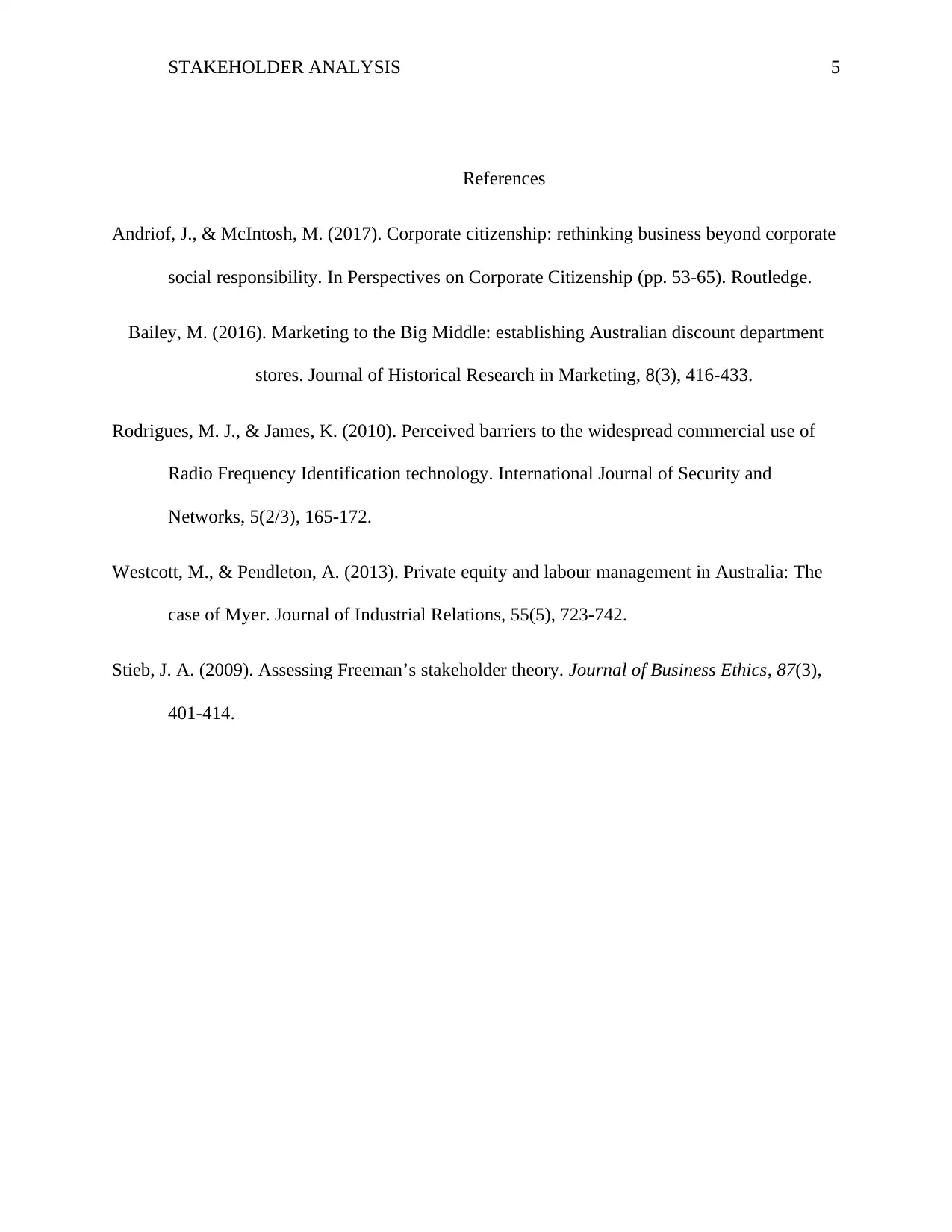
STAKEHOLDER ANALYSIS 5
References
Andriof, J., & McIntosh, M. (2017). Corporate citizenship: rethinking business beyond corporate
social responsibility. In Perspectives on Corporate Citizenship (pp. 53-65). Routledge.
Bailey, M. (2016). Marketing to the Big Middle: establishing Australian discount department
stores. Journal of Historical Research in Marketing, 8(3), 416-433.
Rodrigues, M. J., & James, K. (2010). Perceived barriers to the widespread commercial use of
Radio Frequency Identification technology. International Journal of Security and
Networks, 5(2/3), 165-172.
Westcott, M., & Pendleton, A. (2013). Private equity and labour management in Australia: The
case of Myer. Journal of Industrial Relations, 55(5), 723-742.
Stieb, J. A. (2009). Assessing Freeman’s stakeholder theory. Journal of Business Ethics, 87(3),
401-414.
References
Andriof, J., & McIntosh, M. (2017). Corporate citizenship: rethinking business beyond corporate
social responsibility. In Perspectives on Corporate Citizenship (pp. 53-65). Routledge.
Bailey, M. (2016). Marketing to the Big Middle: establishing Australian discount department
stores. Journal of Historical Research in Marketing, 8(3), 416-433.
Rodrigues, M. J., & James, K. (2010). Perceived barriers to the widespread commercial use of
Radio Frequency Identification technology. International Journal of Security and
Networks, 5(2/3), 165-172.
Westcott, M., & Pendleton, A. (2013). Private equity and labour management in Australia: The
case of Myer. Journal of Industrial Relations, 55(5), 723-742.
Stieb, J. A. (2009). Assessing Freeman’s stakeholder theory. Journal of Business Ethics, 87(3),
401-414.
1 out of 5
Related Documents
Your All-in-One AI-Powered Toolkit for Academic Success.
+13062052269
info@desklib.com
Available 24*7 on WhatsApp / Email
![[object Object]](/_next/static/media/star-bottom.7253800d.svg)
Unlock your academic potential
Copyright © 2020–2025 A2Z Services. All Rights Reserved. Developed and managed by ZUCOL.





